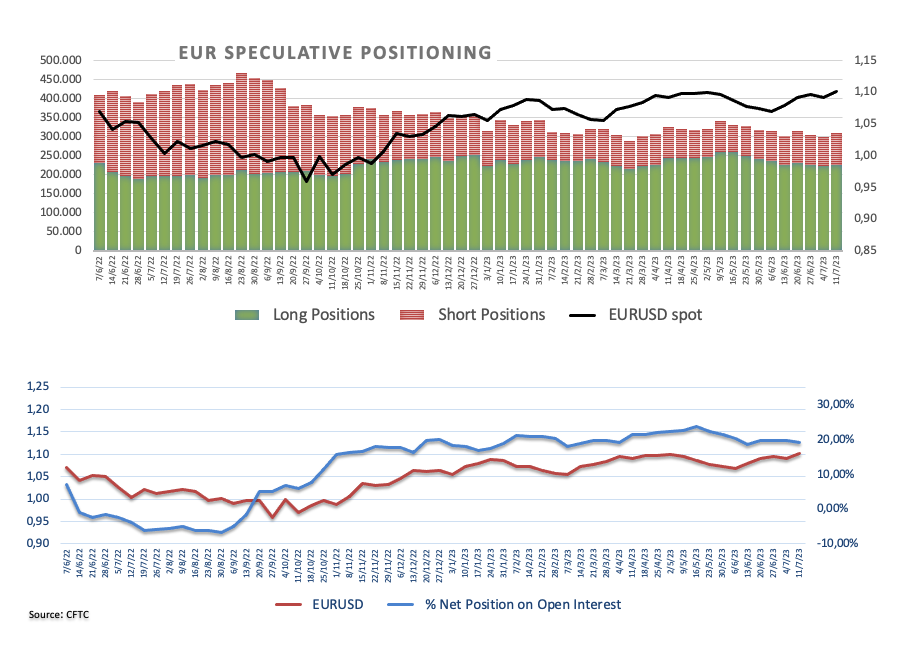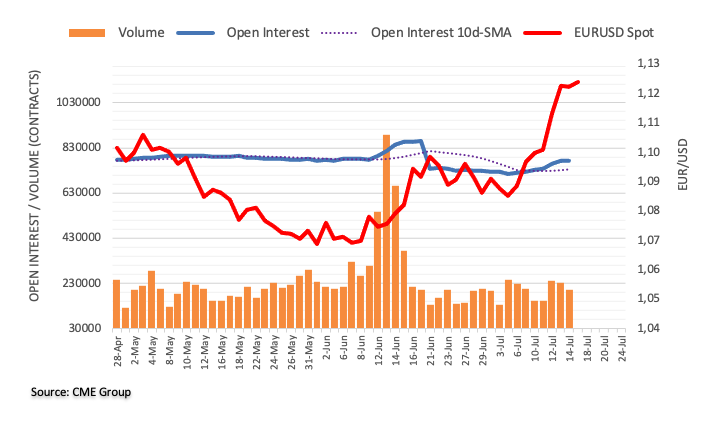Euro advances further and targets 1.1250

- Euro maintains an inconclusive mood near recent tops vs. the US Dollar.
- Stocks in Europe open Monday’s session with a mixed bias.
- EUR/USD keeps the trade around the 1.1240/45 band on Monday.
- Mixed Chinese results seem to have bolstered the risk complex so far.
- The NY Empire State index will be next on tap on the US calendar.
The Euro (EUR) alternates gains with losses around the 1.1240 zone vs. the US Dollar (USD) in the wake of the opening bell in the old continent at the beginning of the week.
In the meantime, spot keeps the trade in the area of yearly highs well north of 1.1200 the figure on the back of the equally irresolute price action around the Greenback, all against the backdrop of steady consensus around another 25 bps rate hike by the Federal Reserve and the European Central Bank (ECB) later in the month.
The possibility that the Fed may be nearing the end of its tightening campaign is contributing to the lack of traction in the Greenback. This view has gained momentum recently, as there are indications of cooling US consumer prices and a persistent downward trend in producer prices.
At present, the market has already largely priced in the expected 25 bps rate hike by both the ECB and the Fed. However, there is still much discussion about the potential future actions of these central banks as they work to normalize their monetary policies, particularly with growing concerns about a possible economic slowdown on both sides of the Atlantic.
According to the latest CFTC Positioning Report, net longs in EUR dropped to around 140.1K contracts in the week ending on July 11, which is the lowest level seen since mid-March.
In the US calendar, the NY Empire State manufacturing gauge will be the sole release on Monday.
Daily digest market movers: Euro attempts some consolidation near 1.1240
- The EUR regains some traction above 1.1240 vs. the USD on Monday.
- The risk-on mood looks propped up by Chinese data releases.
- The USD Index fails to regain the 100.00 hurdle and above.
- Further Fed tightening beyond July looks doubtful.
- Gold, Oil add to recent losses so far on Monday.
Technical Analysis: Euro faces extra gains near term
The ongoing price action in EUR/USD hints at the idea that further gains might be in store in the short-term horizon. However, the current pair’s overbought condition (as per the daily RSI near 75) opens the door to a potential near-term technical correction.
The pair printed a new 2023 high at 1.1245 on July 17. Once this level is cleared, there are no resistance levels of significance until the 2022 peak of 1.1495 recorded on February 10.
On the downside, the 1.1000 region emerges as a psychological support seconded by provisional support at the 55-day and 100-day SMAs at 1.0886 and 1.0859, respectively, ahead of the July low of 1.0833 (July 6). The breakdown of this region should meet the next contention area at the key 200-day SMA at 1.0658 prior to the May low of 1.0635 (May 31). South from here emerges the March low of 1.0516 (March 15) before the 2023 low of 1.0481 (January 6).
Furthermore, the constructive view of EUR/USD appears unchanged as long as the pair trades above the key 200-day SMA.
The ongoing bullish view in the pair is also supported by the current uptrend in open interest, which saw an increase of more than 1K contracts on Friday, according to flash data from CME Group.
Euro FAQs
The Euro is the currency for the 20 European Union countries that belong to the Eurozone. It is the second most heavily traded currency in the world behind the US Dollar. In 2022, it accounted for 31% of all foreign exchange transactions, with an average daily turnover of over $2.2 trillion a day.
EUR/USD is the most heavily traded currency pair in the world, accounting for an estimated 30% off all transactions, followed by EUR/JPY (4%), EUR/GBP (3%) and EUR/AUD (2%).
The European Central Bank (ECB) in Frankfurt, Germany, is the reserve bank for the Eurozone. The ECB sets interest rates and manages monetary policy.
The ECB’s primary mandate is to maintain price stability, which means either controlling inflation or stimulating growth. Its primary tool is the raising or lowering of interest rates. Relatively high interest rates – or the expectation of higher rates – will usually benefit the Euro and vice versa.
The ECB Governing Council makes monetary policy decisions at meetings held eight times a year. Decisions are made by heads of the Eurozone national banks and six permanent members, including the President of the ECB, Christine Lagarde.
Eurozone inflation data, measured by the Harmonized Index of Consumer Prices (HICP), is an important econometric for the Euro. If inflation rises more than expected, especially if above the ECB’s 2% target, it obliges the ECB to raise interest rates to bring it back under control.
Relatively high interest rates compared to its counterparts will usually benefit the Euro, as it makes the region more attractive as a place for global investors to park their money.
Data releases gauge the health of the economy and can impact on the Euro. Indicators such as GDP, Manufacturing and Services PMIs, employment, and consumer sentiment surveys can all influence the direction of the single currency.
A strong economy is good for the Euro. Not only does it attract more foreign investment but it may encourage the ECB to put up interest rates, which will directly strengthen the Euro. Otherwise, if economic data is weak, the Euro is likely to fall.
Economic data for the four largest economies in the euro area (Germany, France, Italy and Spain) are especially significant, as they account for 75% of the Eurozone’s economy.
Another significant data release for the Euro is the Trade Balance. This indicator measures the difference between what a country earns from its exports and what it spends on imports over a given period.
If a country produces highly sought after exports then its currency will gain in value purely from the extra demand created from foreign buyers seeking to purchase these goods. Therefore, a positive net Trade Balance strengthens a currency and vice versa for a negative balance.

